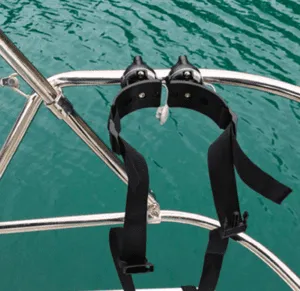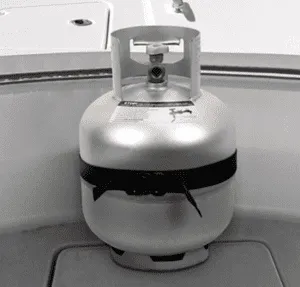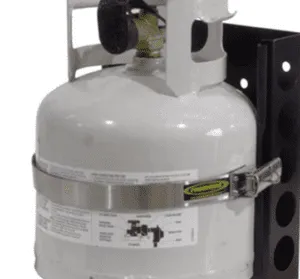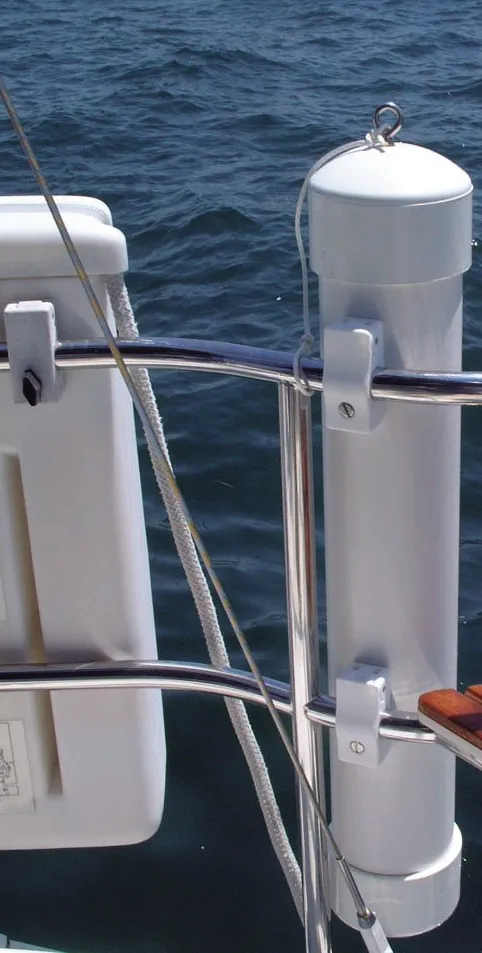Disposable propane cylinders are darn handy, powering stern-rail grills, propane torches and catalytic cabin heaters. I’ve also had the valves fail twice, the result of saltwater corrosion, age or just cheap manufacturing. In one case the hissing was obvious, but the other very nearly went unnoticed. Had I stored it away in the cabin or even a lazarette that vented to the bilge, just one spark would have given my boat a makeover from the waterline up. More recently, I had a home shop cylinder that had never seen saltwater fail, making me wonder just how unreliable the tank’s internal valves can be.
We’ve reported on the need for proper propane installation, including vented lockers and leak detectors (see “Some Propane Do’s and Don’ts” ). We’ve even reported on miniature on-deck storage for 14-ounce and 1-pound bottles. Our experience convinced us there are a few more details that need to be touched on.
THE BASICS
Propane is about 50 percent heavier than air, so it tends to settle to the lowest reaches of the boat. If the leak is on the countertop and there is some ventilation, most of the gas will mix with ambient air and leave the cabin before it gets a chance to settle. Once mixed with the air, like the alcohol in your beer, it will not separate or float to the top.
On the other hand, if the propane cylinder is stored in a locker connected to the bilge, much of the propane will concentrate in the lowest area. The smallest amount of propane required to cause an explosion (lower explosive limit, or LEL) is about 2.1 percent by volume, or about 2 ounces per 100 cubic feet. The bilge of a typical sailboat ranges from 100-400 cubic feet, so just a few ounces raises the risk of explosion.
Although propane itself is odorless, manufacturers add a rotten eggs scent (25 ppm ethyl mercaptan) so that you will smell a leak. Unfortunately, since some people can’t smell it, and everybody becomes less aware of it over time, you can’t rely on this. If you have bottles larger than 1-pound (typical barbecue bottles are 20 pounds) install a leak detection system with sensors at a low point in the cabin, linked to a fail-safe solenoid located at the tank.
Do not store cylinders—even small bottles—below decks or in lockers that vent below decks. Do not store small bottles in the propane locker; that space is only for the bottles that are installed there and nothing else. If you’re lucky, the boat has a vented locker for portable gasoline tanks. Otherwise, keep the bottles on deck, typically in tubes (see “Pint-sized Propane Locker”). Do not store them attached to the appliance below decks.
Do not store propane cylinders in your house or garage. The local fire code generally limits you to two one-pound bottles in the house, attached garage, or detached garage. Larger bottles are NOT permitted, including the grill parked in the garage in front of your car. It should be outside, either under a cover or in an open-sided shed. Do not store over 120 F; on-deck storage should be white and don’t keep cylinders in your car.
Do not refill disposable propane cylinders. Commercial refilling or transport across state lines carries a $500,000 fine and five years in prison. If that doesn’t concern you, consider burning to death, which has happened. The thin walls do not take well to corrosion or repeated flexing. They do not have an over fill prevention device, making them vulnerable to over pressurization in the summer heat. Given that some fail on the first fill, it’s just a really bad idea. You’ll find instructions online, but it’s a really, really bad idea. The U.S. Department of Transportation offers this informational YouTube video.
For $35, Flame King will sell you a DOT certified refillable 1-pound bottle and kit that allows refilling from a larger bottle. Additional bottles are about $10. Obviously, you need to follow the instructions meticulously and do this away from ignition sources and static. You will have fewer empties to dispose of and you will save $3-$4 per refill. Whether it is worth the effort depends on usage. Personally, I can’t see the expense and risk; if you are using that many small cylinders, maybe you need a larger cylinder with proper installation.
VERTICAL VS. HORIZONTAL
In order to be compliant with the American Boat and Yacht Council (ABYC) standards regarding onboard propane storage (A-1), an onboard propane system can use a only vertically oriented tank. From what we can surmise, using horizontal LPG tanks in U.S. boats is rare, but Europeans and South Africans, on the other hand, use both vertical and horizontal.
Most portable LPG tanks sold in the U.S. are called “DOT” tanks because they are built to conform to design and usage regulations established by the Federal Department of Transportation. Both horizontally and vertically mounted portable DOT tanks are available, but note that they are not interchangeable. They must be stored, filled, and used only in the specified horizontal or vertical mounting position.
LPG tanks designed for horizontal use have welded “feet” or mounts and are specifically plumbed for horizontal use; the internal valve has a bent tube, allowing withdrawal from the vapor space only. Using a vertical tank in a horizontal position—particularly on a cold day, before the liquid LP in the hose can vaporize—may allow liquid LPG to flow to the burner, giving you the equivalent of a poor-man’s flame thrower when trying to make that morning cup of coffee. This could also occur on warmer days, because of the boat’s hobby-horsing.
One symptom of mounting a vertical tank horizontally is that the flame at the burner will have minuscule “flickering” (caused by liquid LPG droplets igniting in the flame). The hose will also typically be cold and sweating (covered in condensation). The emergency relief valve (internal/external at tank) can also freeze in the open position. If this happens, any heat that causes high pressure in the tank (strong sunlight on a hot day for example) may cause it to vent liquid LPG, possibly the entire contents of the tank.
PROPANE CLAMPS AND BRACKETS
1. A do-it-yourself PVC stowage container for small propane bottles attaches to the sternrail. Note the ring-eye in the cap for a lanyard to prevent it from falling overboard. Be sure to mount the container far away from the barbecue grill.

2. Injection-molded nylon rail clamps from Sea Dog can be used to mount everything from solar panels to cup holders. Although the container does not need to be airtight, keeping out salt air can extend the life of the bottles. For sealing any holes drilled in the container, you can use Sudbury Elastomeric Sealant, one of the few sealants that bonds well to plastics without pre-treating (“Tips for Caulking Polyethylene”).

3. New Zealand-based Railblaza builds a modular, nylon reinforced cradle with webbing traps that can be adjusted to fit gas bottles or dive bottles. The cradle can be combined with a pair of the company’s rail clamps.

4. The Railblaza clamps can also be mounted on an aluminum track system for bulkhead mounting.

5. The powder-coated Power Tank uses a lockable stainless steel band to secure propane tanks. The bracket is offered in multiple sizes to fit different tanks, including 17 or 22-lb. Viking composite tanks.
This article was first published June 20, 2022 and has been updated.




































Hey Drew, Nice article on propane. I’ve been on a vision quest over the last year to replace and reanimate the entire propane system on my ‘74 Ranger 29. Success is warm and tasty with cabin heat and full stove/oven piped in. I was surprised to see one of the common, at least here in the PNW, options not identified. These have been around since I was a kid and probably longer. My current boat came with one thankfully, had it not ai would have purchased a new one.
https://www.suremarineservice.com/Galley/Propane-Railmount-Bracket-Assembly/001-749A.html
Holds a 6# tank off the back side of stern rail, any leaking would slip off the transom and away.
Hi Drew, I’m pulling together a safe way to store and use the 1# propane cylinders on my boat. This is because I’ve concluded there is no way to store the 20# tanks in a way that is ABYC compliant on my 55-year-old boat.
I already use the rail-mounted Magma grill, and am putting together a plan to expand my use.
My plan has 2 parts: I need a cabin heater for short-term use. I will be installing a propane and CO monitor, and a blower/vent in the bilge of my cabin. With this in place, I’m considering using a Mr. Buddy radiant heater, with proper ventilation. This should take about 15 minutes to warm up my cabin in the morning. The 1# cylinder would of course be stored outside the cockpit before and after using the heater. So the question is: is this safe? You mentioned a catalytic heater…is this better or worse than the radiant heater?
The second part of my plan is storing the cylinders. I like the vertical PVC storage locker and can fit one on my boat. The part I don’t like is that it is in direct sunlight. My potential plan for dealing with this is to put that locker inside a slightly larger PVC pipe that is open on the bottom and has a ventilated cap on the top. When the sun heats the air between the two pipes, it will just rise and draw in cooler air from the bottom. I’m wondering if this is a good move or if I’m over-thinking it.
Thanks!
What is reason 1 lb. tank(s) should not be stored in same locker designed to store larger tanks?
Earle: There is no reason a 1-pound tank could not be stored in the propane locker if there is room and specific precautions are taken. The 1-pound cylinder must be secured so that it cannot chafe or impact itself, the other tanks, the regulator, or the hoses in severe weather. Thus, often the answer is that it is not practical. You can’t just stuff it in there. It needs to be secured in a bracket, like a fire extinguisher.
Nothing should be stored in a propane locker other than propane tanks.